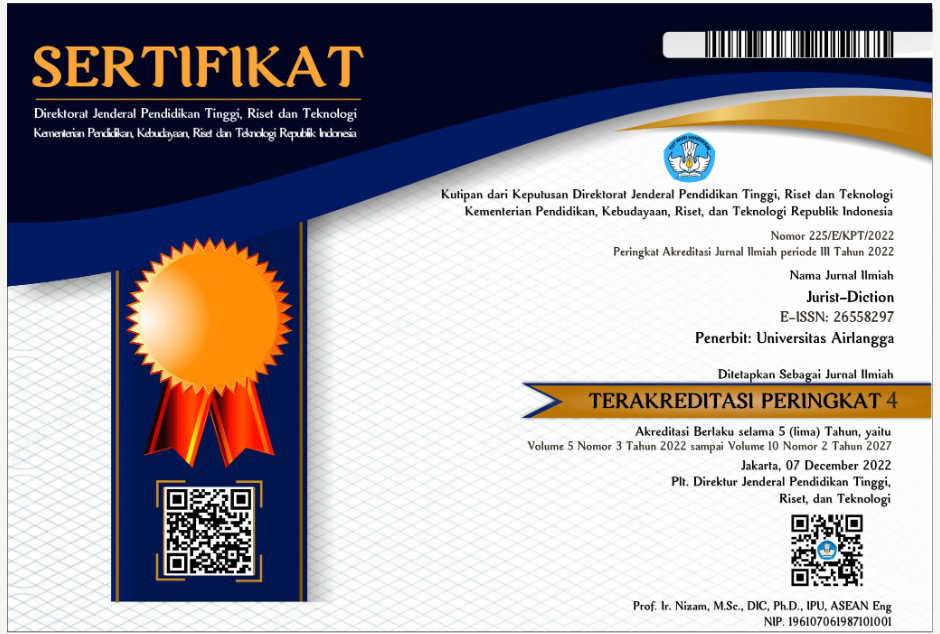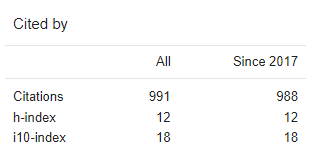Autonomous Weapon Systems dan Legalitas Penggunaannya Dalam Hukum Humaniter Internasional
Downloads
Perkembangan teknologi persenjataan mengarah pada penerapan konsep dehumanization yang tidak lagi membutuhkan keterlibatan manusia dalam proses penggunaan senjata, sehingga senjata dapat dilengkapi dengan sistem otomatis dan otonom. Salah satu bentuk senjata yang dilengkapi dengan sistem otonom adalah autonomous weapon systems. Autonomous weapon systems
mempunyai kemampuan untuk memilih target dan melakukan penyerangan terhadap target, tanpa intervensi manusia. Dalam Hukum Humaniter Internasional, tidak ada pengaturan yang secara spesifik mengatur mengenai autonomous weapon systems. Sehingga perlu dilakukan tinjauan hukum untuk menentukan apakah penggunaan autonomous weapon systems dilarang atau tidak oleh Hukum Humaniter Internasional. Penelitian ini merupakan penelitian hukum yang bertujuan untuk mengkaji keabsahan penggunaan autonomous weapon systems dalam Hukum Humaniter Internasional, yang meliputi: pengaturan Hukum Humaniter Internasional mengenai penggunaan senjata dalam konflik bersenjata, dan keabsahan penggunaan autonomous weapon systems dalam pengaturan Hukum Humaniter Internasional. Hasil penelitian ini menunjukkan bahwa autonomous weapon systems melanggar ketentuan Hukum Humaniter Internasional yaitu prinsip pembedaan, prinsip proporsionalitas, prinsip pembatasan, serta prinsip-prinsip dasar kemanusiaan dan kesadaran
umum dalam Martens Clause.
Buku
H.J. Morgenthau, Kenneth W. Thompson, Politik Antar Bangsa (Yayasan Pustaka Obor 2010).
Haryomataram, Sekelumit tentang Hukum Humaniter Internasional (Sebelas Maret University Press 1994).
Jarna Petman, Autonomous Weapons Systems and International Humanitarian Law: ‘Out of The Loop'? (Unigrafia Oy 2017).
Krishnan Armin, Killer Robots Legality and Ethicality of utonomous Weapons (Ashgatae Pubishing Company 2009).
Umesh Chandra Jha, Killer Robots: Lethal Autonomous Weapon Systems Legal, Ethical, and Moral Challenges (Vij Books India Pvt Ltd 2016).
Jurnal
International Committee of the Red Cross Geneva, ‘A Guide to the Legal Review of New Weapons, Means and Methods of Warfare: Measures to Implement Article 36 of Additional Protocol I of 1977' (2006) 88 International Review of theRed Cross.
Neil Davidson, ‘A Legal Perspective: Autonomous Weapon Systems under International Humanitarian Law' (2007) 30 UNODA Occasional Papers.
Tesis
Ghasemi, Adja Hosseini, Semi-Autonomous Weapon Systems in International Humanitarian Law - A study of the new decision-making and responsibility issue in International Humanitarian Law relating to Semi-Autonomous Weapon Systems (Lund University 2014).
Perjanjian Internasional
Convention (IV) respecting the Laws and Customs of War on Land and its annex: Regulations concerning the Laws and Customs of War on Land. The Hague, 18 October 1907.
Convention on Prohibitions or Restrictions on the Use of Certain Conventional Weapons Which May be Deemed to be Excessively Injurious or to Have Indiscriminate Effects. Geneva, 10 October 1980.
Declaration Renouncing the Use, in Time of War, of Explosive Projectiles Under 400 Grammes Weight. Saint Petersburg, 29 November / 11 December 1868.
Protocol Additional to the Geneva Conventions of 12 August 1949, and relating to the Protection of Victims of International Armed Conflicts (Protocol I), 8 June 1977.
Rome Statute of the International Criminal Court, 17 July 1998.
Jurist-Diction (P-ISSN 2721-8392, E-ISSN 2655-8297), published by Universitas Airlangga, is licensed under the Creative Commons Attribution 4.0 International License (CC BY 4.0).
This license permits users to:
- Share – copy and redistribute the material in any medium or format;
- Adapt – remix, transform, and build upon the material for any purpose, including commercial use.
These freedoms are granted under the following conditions:
Attribution – You must provide appropriate credit, include a link to the license, and indicate if any changes were made. This may be done in any reasonable manner, but not in a way that suggests the licensor endorses you or your use.
No additional restrictions – You may not apply legal terms or technological measures that restrict others from exercising the rights granted under the license.
Note: As of Volume 5, No. 1 (2022), Jurist-Diction has adopted the Creative Commons Attribution 4.0 International License (CC BY 4.0), replacing its previous license (CC BY-NC-SA).


















